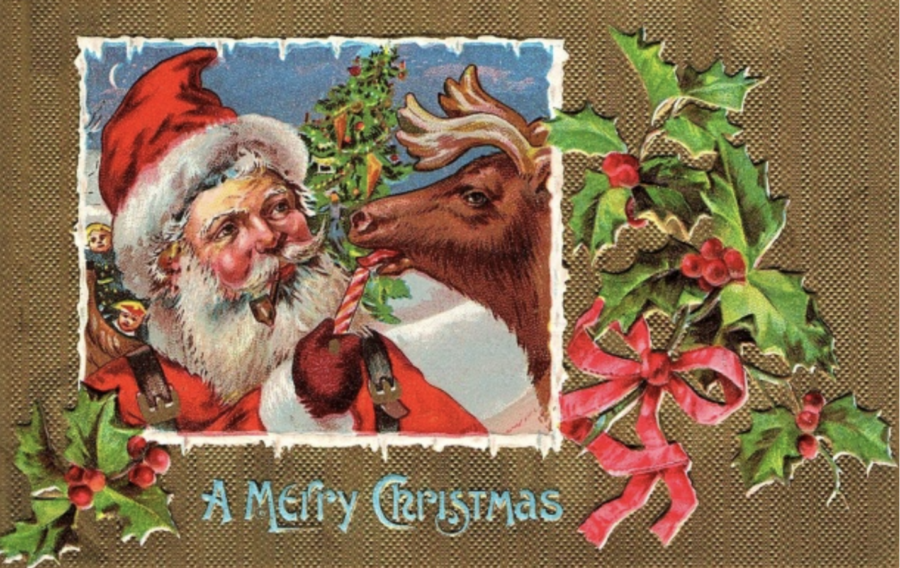The celebration of Christmas: Secular and sacred
Christmas is considered both religious and secular, allowing it to be a federal holiday despite it being a Christian holiday.
Licensed by Public Domain Pictures
Santa Claus did not originate as a marketing ploy, but rather an ode to a monk named St. Nicholas.
Christmas can be a difficult holiday to decipher in terms of its origins and traditions. To some, it is an oversaturated mockery of the Christian sacred celebration, and to others, it is the embodiment of Christian values without mandating holiness.
The creation of Christmas was not very biblical as some may otherwise believe. The Bible does not mention the date that Jesus was born and many Puritans deny the legitimacy of celebrating Christmas as a wholly Christian holiday.
Despite many assumptions that Jesus’s birthday was in the spring due to the shepherds’ part in the story, Pope Julius I decided that Jesus’s birth would be celebrated on Dec. 25. Many historians believe that this date was chosen out of fourth-century commercialization and the date was to boost the holiday’s popularity by occurring around the same time as the pagan Saturnalia festival and absorbing Saturnalia’s popularity and traditions.
Due to the decision of Christmas’s date, the holiday may have been more celebrated during other winter solstice festivals, but the church lost control over how it was celebrated.
In terms of the American application of Christmas in the 1600s, the pilgrims were Orthodox Puritans who saw Christmas as an over-popularized, unholy day, which led to the ban of Christmas celebrations in Boston from 1659 to 1681. However, Captain John Smith supported the celebration of Christmas in Jamestown, and he thought it should be enjoyed by everyone.
Nineteenth-century American writer Washington Irving promoted the St. Nicholas character and idea in his stories, and eventually, he inspired the creation of Santa Claus. Irving believed that Christmas is meant to be a peaceful and kind holiday that brings all groups of people together no matter their social class. His promotion of togetherness among God’s children and less about the birth of God’s child was widely accepted.
Similarly to Irving, English writer Charles Dickens wrote the story, “A Christmas Carol,” upholding the message of kindness and charity during the Christmas season. His story inspired England and the United States, by encompassing the benefits of celebrating Christmas.
Many see these stories as Christian propaganda, yet others view these tales as optimistic promotions of community and faith that have Christian origins, but a secular purpose.
During the 19th century, families became closer and more conscious of children’s emotional needs. So, Christmas became a day that families could somewhat “spoil” their children with gifts, unrelated to the biblical story of the three kings’ gifts to Jesus.
Christmas has become a traditionally and culturally based holiday that celebrates the birth of Jesus but also includes other figures to symbolize Christian sentiments. For instance, Santa Claus represents Christian values without being a biblical figure that may turn some non-Christians off from the holiday and its purpose.
Santa Claus did not originate as a marketing ploy, but rather an ode to a monk named St. Nicholas. St. Nicholas was born in Turkey during the third century and he is known to have given away all of his wealth to others and traveled to help the sick and poor people around the world.
American culture adopted his story as the protector of children in the late 18th century in New York due to Dutch families bringing their tradition of honoring the death anniversary of Saint Nicholas to their homes in America. The Dutch regarded St. Nicholas as either “Sint Nikolaas” or “Sinter Klaas” which is where the abbreviation, “Santa Claus,” originated.
The look of Santa Claus stemmed from the 19th-century Christmas poem by Episcopal minister Clement Clarke Moore titled “An Account of a Visit from St. Nicholas.” This story is most known by its first line, “Twas The Night Before Christmas,” and depicted St. Nicholas/Santa Claus as a jolly, old man who flew around the world on a sled led by reindeer to deliver gifts to children.
Political cartoonist Thomas Nast drew inspiration from Moore’s poem, and in 1881, he created the iconic image of Santa Claus in a red suit, a white beard, a sack of toys for children, and a jolly disposition.
Christmas traditions have rich cultural origins and were not arbitrarily brought about. Most of the traditions are embodiments of historical events that represent Christmas either biblically or virtuously.
The legends of Christmas trees are vast. One is about Martin Luther, a Protestant figure, who is said to have spread the belief that pine trees represented God and his goodness.
Yet, the non-mythical history of the Christmas tree tradition is rooted in Germany during the Middle Ages, and the tradition to decorate the tree and put presents beneath it is credited to the United Kingdom. An engraving circulated throughout the world of Queen Victoria, Prince Albert, and their children gathered around a decorated Christmas tree looking at gifts beneath the branches, which was published in 1848 by the Illustrated London News.
To reaffirm Christian values of gratitude, hope, and giving, the tradition to leave cookies for Santa began during the Great Depression in America to represent thankfulness even when there seems to be nothing left to be grateful for.
Pascack Hills sophomore Sophia Padilla shared her opinions on Santa as someone who celebrates Christmas.
“Although [Christmas] is a religious holiday, Santa gives kids something to grab onto mentally with the tales and happiness, and the details of it may be revealed later in life,” she said.
Similar to Padilla, even some Christians think that Santa replacing Jesus in some respects and his mythical tales could be a good way for children to grasp faith at a young age before encountering the complicated truths of Christianity.
Padilla added, “I think it’s fine that people who aren’t Christian celebrate Christmas because the spirit of Christmas is spending time with others and giving to others.”
Christmas is considered both religious and secular, allowing it to be a federal holiday despite it being a Christian holiday. It was deemed so in 1870 due to its secular reasons to be celebrated such as the dedication of giving to others and spending time with family/friends instead of the religious purpose being the remembrance of Jesus’s birth.
Yet, Christmas’s place as a federal holiday is also considered to be a means of profiting off of its commercialization to boost consumer spending, helping the American economy.
Sophomore Maya Rose shared her opinion on the commercialization of Christmas as someone who celebrates Hanukkah.
“To me, Christmas can sometimes be bothersome because it is prioritized over other holiday celebrations such as Hanukkah or Kwanzaa. This makes non-celebrators ashamed of their own celebration and religion. Non-celebrators can clearly celebrate the holiday, but don’t disregard their religion,” she said.
Junior Gururoop Kaur, a Sikh, was asked about her opinions and perception of Christmas in the U.S. as a non-celebrator.
“Getting gifts is so normalized that I’m used to it. [I think] Christmas is such a huge holiday since people like giving and receiving gifts, and it’s a great opportunity for businesses to make money and thrive. I don’t celebrate Christmas…but I like the vibes and watching Christmas-themed movies,” she said.
A Google search of Christmas comes up with stockings, decorated trees, and Santa before an image of Jesus, which has raised concerns, and while Christmas’s commercialization may have put focus on profit and spending, it has also spread joy to the world through its moral mission that would have likely not have grasped such a big following if it was not for the stories, shows, music, and more centered around the holiday.
Sophomore Laila Collas, a Christian, shared her thoughts on the celebration of Christmas.
“Christmas, while mainly rooted in Christianity shouldn’t be exclusive or kept from other people. . . It feels even more Christian to want another person who is from a different background to take part in a Christian holiday and be at peace,” she said.
Many celebrators throughout the centuries have added to the holiday traditions. Eventually, the holiday became a melting pot of different cultures where all could celebrate together and join in the sentiment of Christmas: family, community, and giving back.
Sources:
https://www.history.com/topics/christmas/history-of-christmas
https://time.com/5736523/history-of-christmas-trees/
https://www.britannica.com/event/The-Christmas-Truce

Paige Geanopulos is a senior at Hills. She joined the Trailblazer her freshman year as a staff writer, became the editor for the In-Depth section her sophomore year, and was the editor for the School News section her junior year. This year, Geanopulos looks forward to being the publication's Editor-in-Chief and continuing to write, edit, and manage stories for the Hills community.
Fun fact: Geanopulos has gone cliff diving in Naxos, Greece!












































